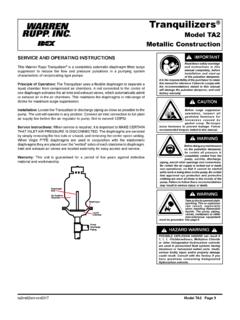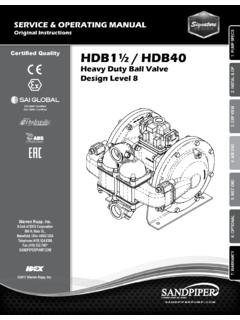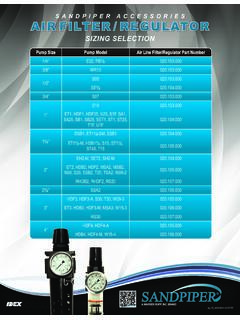Transcription of SERVICE AND OPERATING MANUAL - sp.salesmrc.com
1 Pokdl5sm-rev0216 Copyright 2016 Warren Rupp, Inc. All rights Rupp, Inc. A Unit of IDEX Corporation 800 N. Main St., Mansfield, Ohio 44902 USA Telephone (419) 524-8388 Fax (419) 522-7867 SERVICE AND OPERATING MANUAL PULSE OUTPUT KITD esign Level 5 Pulse Output InterfaceThe Pulse Output Interface Kits are designed for easy field installation. The Kits are also available factory-installed on new pumps. The Pulse Output Interface Kit mounts on the pump and provides electrical pulses to operate the Warren Rupp Batch Control/Stroke Counter, or a customer-supplied control.
2 The unit creates an electrical interface between the control and the air-powered pump. Pulse Output Kits can be purchased separately, for use in applications where a process controller is already present in a system. This provides a direct interface with the pump and the customer s pump stroke generates a signal through a proximity sensor (PNP) on either end of the air valve. As the air valve reciprocates back and forth during pump operation, targets on either end of the spool activate their respective proximity sensors.
3 Each sensor signals the control to register one count on the stroke counter / batch control unit. This method provides a positive signal for every pump stroke, but with very few wearing a Factory-Installed Kit Pulse Interface Kits are available factory-installed on new SANDPIPER and MARATHON diaphragm pumps. When installing, always refer to the SERVICE MANUAL for pump installation and operation recommendations. After installing the pump, connect the interface to the control source. To connect the interface to the control source: Install input cable according to the wiring diagram for your specific interface kit.
4 Connect to Warren Rupp Batch Controller or existing system Installation of KitBefore adding an interface kit to an existing SANDPIPER or MARATHON pump, verify the compatibility of the pump model, kit number and voltage being used. A complete listing appears on page 3 Field Installation Remove the main air valve body assembly and gasket. Install the Pulse Output Kit,and pulse output pump adapter kit tighten and torque the screws according to the pump SERVICE MANUAL instructions.
5 Refer to the applicable wiring diagram when connecting to control ! Pulse Output Interface Kits cannot be used if pump is to be Pulse Output Kit Page 2 Pump Selection & InstallationAir-operated, double diaphragm pumps (AODD) are semi-positive displacement pumps designed with flexible diaphragms. AODD have successfully been applied in metering and batching applications where system design allows for minimal variation of: Air Inlet Pressure Suction Head/Lift Discharge Head Pump Speed (Stroke Rate) Product Viscosity NPSH(a)Variations of any of the above can result in variable, volumetric displacement per pumping stroke which normally holds to +/- 1% to 3% repeatability.
6 To verify actual displacement in your application, it is essential to follow a calibration procedure. This allows the batch control to be set for the actual average displacement per pump stroke. The larger the calibration volume, the more precise the the normal pump sizing procedures using published data. DO NOT OVERSIZE THE PUMP. Select the smallest pump suitable for your use to ensure greater accuracy. The batch size from a SANDPIPER pump will be within +/- one ensure consistent repeating of the batch size, keep the suction piping short, straight, simple, and as large a diameter as is pressure across the check valves of the pump will insure that the check valves seat properly and consistently.
7 Discharge pressure must always be greater than the suction pressure in the consistent fluid displacement and system accuracy it is mandatory to keep the discharge line full of product from the pump to the point of discharge. A one-way check valve installed in the end of the discharge line will accomplish suction lift applications the pump must be kept primed at all times. Suction lift must be kept to a minimum and a foot valve may be required in the suction line to keep the pump flooded suction applications a back pressure device located in the discharge line may be required to insure sufficient differential pressure across the pump check valves.
8 The one-way check valve mentioned above may provide sufficient back pressure to properly seat the pump check valves although additional means may be necessary in some an air line pressure regulator. This ensures a constant air pressure feed to the pump eliminating low to peak usage pressure spikes which will increase and or decrease the stroke rate of the pump resulting in variable (non-controlled) ! Safety clip locks pump for security or SERVICE . Pump will NOT operate with safety clip in Proximity Sensors Shift the main air valve spool toward the sensor being replaced.
9 Lock the spool in place by inserting the safety clip (included in the kit) through the small hole of the opposite end cap. Disconnect the sensors from terminal junction. Loosen the hex nut holding the proximity sensor in place. Remove the sensor from the end cap. Install the replacement sensor. Set the clearance between the sensor and the actuator pin to .015" (.38mm), using a feeler gauge or shim stock. The gauge or shim stock should slide freely, while making contact. Tighten the hex nut provided with the replacement proximity sensor to lock in place.
10 Reattach terminal juction to proximity sensor Remove the safety clip from the end cap. The pump is now ready for Pulse Output Kit Page 3 Table 1 Pulse Output Interface Kit Selection InstructionsKit NumberCommentStep 1475-244-001 Refer to Page 4475-244-002 Refer to Page 5475-244-002 Refer to Page 6475-244-003 Refer to Page 7 Table 2 Step 2 Pump ClassSizeKit NumberComment1/4"475-245-001 Refer to Page 81/2"475-245-002 Refer to Page 93/4"475-245-002 Refer to Page 9475-245-002 Refer to Page 9 Step 3475-245-003 Refer to Page 101 1/2"475-245-003 Refer to Page 102"475-245-003 Refer to Page






